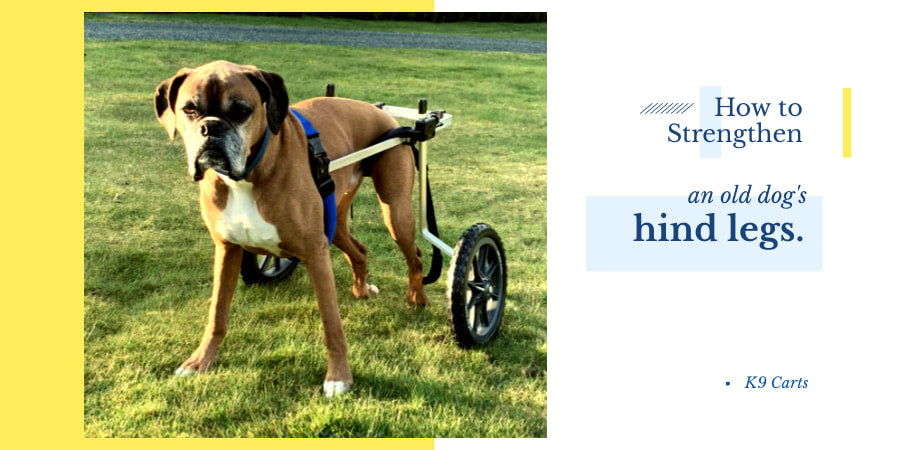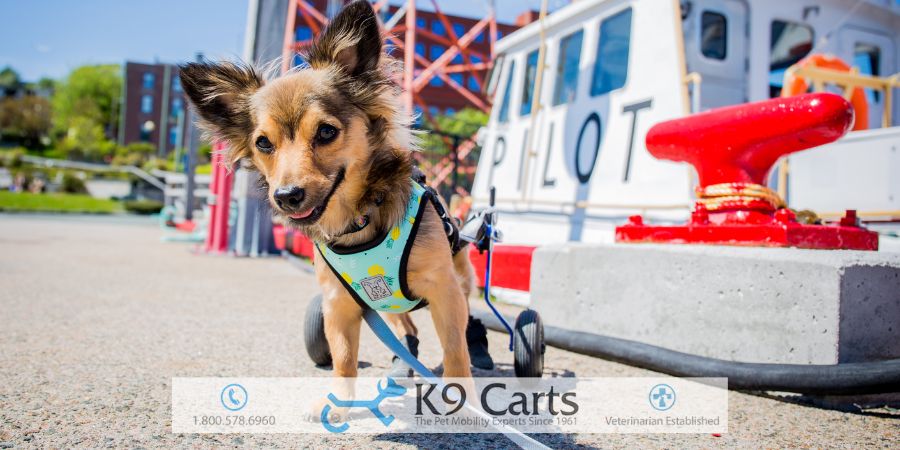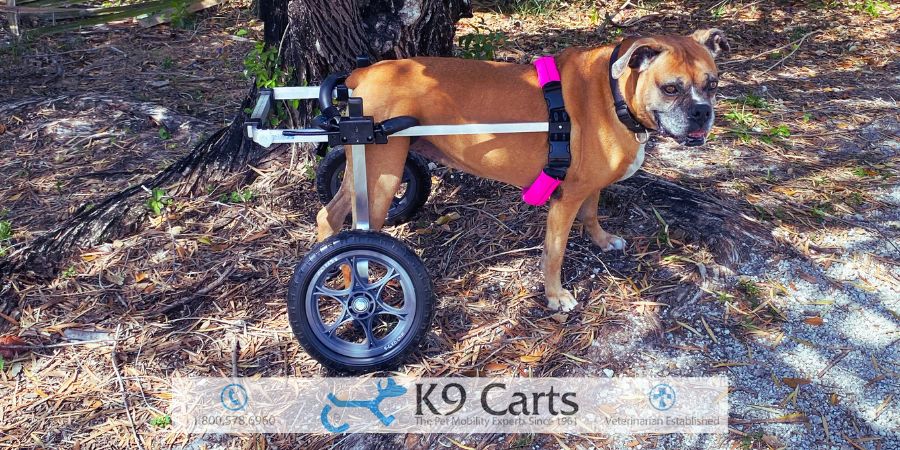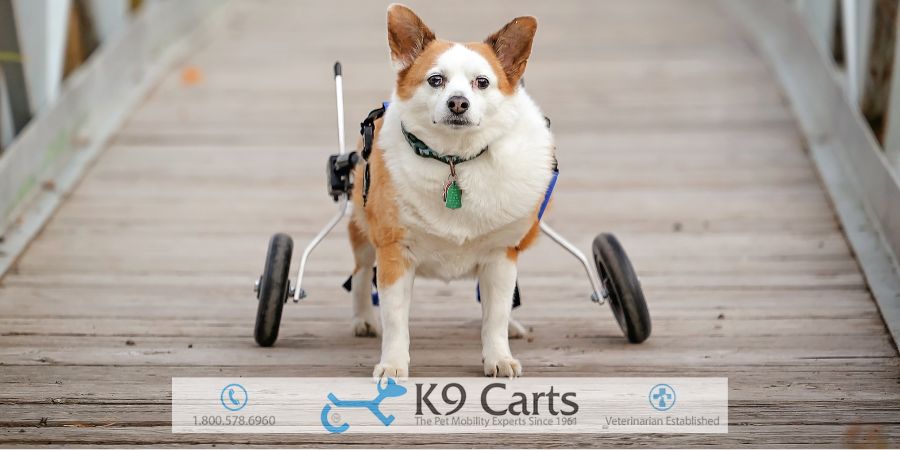How to Strengthen an Old Dog's Hind Legs

While everyone may love the boundless energy and playfulness of puppies, in many respects old dogs make the best companions of all. When you've lived with your four-legged buddy for years, you have a bond that's hard to explain to anyone not familiar with that feeling.
So when your elderly pet starts developing trouble in its hind legs, you can't stand to watch it suffer and struggle. Fortunately, you can take steps to lend strength or stability to an aging dog's hind legs. Take the following information to heart as you seek solutions for your old friend.
What Causes Hind Leg Weakness in Older Dogs?
Since dogs age more rapidly than humans, your own dog's senior years can easily sneak up on you. Most dogs are considered geriatric at around age 7, although large breeds can age more rapidly and toy breeds less rapidly. As the number of years rises, so do the odds of your dog developing an age-related condition that affects hind leg strength and function. The following conditions can lead to hind leg weakness in your senior dog.1. Osteoarthritis
Older dogs, like older humans, commonly develop osteoarthritis. In this form of arthritis, the cartilage that normally minimizes friction in a joint breaks down and thins out, resulting in chronic joint pain, stiffness, and inflammation.2. Hip dysplasia
Hip dysplasia is an inherited condition in which the ball of the hip joint has too much play within the socket. This looseness eventually causes the hip joint to degenerate. Although veterinarians can observe this problem in puppies, the degeneration may take years to grow into a debilitating problem.3. Degenerative myelopathy
This neuromuscular condition, which resembles ALS in humans, occurs less commonly than the conditions listed above, but senior dogs can still suffer from it. In degenerative myelopathy, the outer sheath that insulates nerve fibers breaks down, eventually paralyzing the hind legs.4. Diabetic neuropathy
Diabetic neuropathy represents yet another condition that affects both people and dogs. Since diabetes risk rises with age, senior pets often develop this form of nerve damage, which can affect hind leg function and sensation.
5. Intervertebral disc disease
Intervertebral disc disease (IVDD) occurs more commonly in senior Dachshunds and other small breeds, but larger senior dogs can develop it as well. In this disorder, the discs between spinal vertebrae bulge or herniate, putting pressure on the nerves that relay information to the hind legs.
What Are the Symptoms of Hind Leg Weakness in Dogs?
Unfortunately, your elderly dog can't tell you when it experiences changes in its hind legs such as pain, stiffness, or weakness. However, you can spot the signs of hind leg weakness once you know what to look for. Pay attention to the following telltale symptoms:1. Instability
A senior dog with weak hind legs may display a wobbly gait, difficulty standing up and walking, poor coordination when walking, and a visible trembling in the weakened leg muscles.2. Outward changes
Hind leg problems can produce outward changes in your dog's appearance. Look for weight gain (due to reduced mobility that burns fewer calories), loss of muscle mass in the hind legs, or joints swollen by osteoarthritis.3. Pain
Your pet may yelp in pain when you touch its hind leg, or simply refuse to let you touch it at all. It may also show obvious pain and stiffness when sitting down, standing up, or trying to walk.4. Behavioral changes
A senior dog with weak hind legs may hesitate to go up or down stairs that it previously used all the time. If your pet feels pain or instability from its weakened hind legs, it may lose interest in favorite activities such as playing catch or going for walks.How to Assist or Strengthen an Aging Dog's Hind Legs
You don't have to let your aging dog's hind leg issues ruin its quality of life or deprive it of everyday mobility. The first step in helping your old friend is scheduling a senior pet wellness exam. Your veterinarian can run numerous tests to determine the underlying cause of your pet's hind leg weakness and then recommend steps to help manage the problem. Your dog may find relief from options such as:1. Medication
If your aging dog's hind leg weakness stems from a disease such as diabetes, medication can help get that underlying issue under better control. Anti-inflammatory drugs can also ease joint inflammation and swelling caused by osteoarthritis.2. Dietary changes
Changes in your elderly dog's diet can aid weakened hind legs by offering anti-inflammatory benefits and/or promoting weight loss that takes extra stress off the legs.3. Surgery
In some cases of arthritis, hip dysplasia, and intervertebral disc disease, your veterinarian may recommend surgery to fix abnormal joints or relieve nerve pressure.4. Lifting harness for dogs
A full body lifting harness such as the Help 'Em Up Harness is a helpful tool to assist your aging pup.
5. Dog support wheelchair
A wheelchair that supports the hind legs can give your senior dog great relief from pain, weakness, and instability. These devices feature a pair of large rear-mounted wheels that take much of the weight burden off your dog's hind legs. Metal rails extend from this rear assembly to a harness that fits around your dog's middle.How Weak Hind Legs Can Cause Complications (and What You Can Do About It)
Weak hind legs can mean more than just mobility issues. Changes in your dog's stance and gait can strain other parts of the body and weaken the spinal column, while the inability to exercise can promote obesity (itself a major factor in diabetes, hypertension, and organ failure). That's one more reason you'll want to provide your dog with the assistance it needs sooner rather than later.
A rear support dog wheelchair from K9 Carts can help your canine friend avoid these complications. The balanced support helps to protect the spine and joints while also restoring your dog's ability to walk, play, and generally burn calories, reducing the risk of obesity (and injuries from falling or tripping).
Check out our rear support dog wheelchairs and other assistive devices. If you need any assistance placing your order or measuring your pet for a dog wheelchair, just contact us. We'll be happy to help you help your elderly dog!






